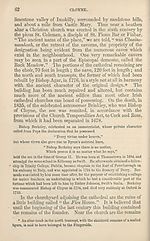Download files
Complete book:
Individual page:
Thumbnail gallery: Grid view | List view

61
CLOYN E.
i A pleasant excursion may be made from Cork, by the
steamers which ply daily to Aghada, to visit the mansion of
Rostellan, and the monastic ruins of Cloyne.
Rostellan Castle, formerly the princely seat of the O’Briens,
Marquesses of Thomond. On the decease of the late Marquess
in 1855, all the family titles became extinct, with the exception
of the Irish Barony of Inchiquin, which descended to his
kinsman Sir Lucius O’Brien, Bart., now Lord Inchiquin. The
I modern mansion, beautifully situated at the eastern end of the
1 Cove of Cork, occupies the site of an ancient castle of the
! Fitzgeralds, who were for centuries seneschals of Imokilly.
ji In the castle is an ancient sword said to have belonged to the
i great Brian Boroimhe, the ancestor of the O’Briens. The
‘ demesne is extensive and well planted. Visitors are freely
admitted. It may be well to continue the excursion on foot,
passing the modest hamlet of Soleen and the contiguous
| property of
: Castle Mary, the seat of Mountifort Longfield, Esq., in
? the vicinity of which is one of those druidical remains, known
| as cromlechs. “ It is an immense mass of limestone of an
oblong shape, one end resting on the ground, and the other
extremity supported by two huge upright stones.” The large
t stone is fifteen feet long by about eight in breadth, and three
to four in thickness. “ Adjoining this great altar is a smaller
one of a triangular shape, and, like the other, it is supported
by two uprights in an inclined position. It is supposed that
this lesser stone might have been used for the purposes of
common sacrifice, while the greater altar was reserved for
1 occasions of extraordinary solemnity.”* The belief that these
j cromlechs were not altars but frame-works for the accumulation
j of cairns, has already been noticed. The writer we have just
quoted states that “ an ingenious conjecture has been advanced,
that they were placed in an inclined position, to allow the
blood of victims slain upon them to run off freely.” Certain
it is that most if not all cromlechs already discovered have an.
inclined position.
CLOYNE, a small but ancient town, is situated in the
* J. S. Coyne.
CLOYN E.
i A pleasant excursion may be made from Cork, by the
steamers which ply daily to Aghada, to visit the mansion of
Rostellan, and the monastic ruins of Cloyne.
Rostellan Castle, formerly the princely seat of the O’Briens,
Marquesses of Thomond. On the decease of the late Marquess
in 1855, all the family titles became extinct, with the exception
of the Irish Barony of Inchiquin, which descended to his
kinsman Sir Lucius O’Brien, Bart., now Lord Inchiquin. The
I modern mansion, beautifully situated at the eastern end of the
1 Cove of Cork, occupies the site of an ancient castle of the
! Fitzgeralds, who were for centuries seneschals of Imokilly.
ji In the castle is an ancient sword said to have belonged to the
i great Brian Boroimhe, the ancestor of the O’Briens. The
‘ demesne is extensive and well planted. Visitors are freely
admitted. It may be well to continue the excursion on foot,
passing the modest hamlet of Soleen and the contiguous
| property of
: Castle Mary, the seat of Mountifort Longfield, Esq., in
? the vicinity of which is one of those druidical remains, known
| as cromlechs. “ It is an immense mass of limestone of an
oblong shape, one end resting on the ground, and the other
extremity supported by two huge upright stones.” The large
t stone is fifteen feet long by about eight in breadth, and three
to four in thickness. “ Adjoining this great altar is a smaller
one of a triangular shape, and, like the other, it is supported
by two uprights in an inclined position. It is supposed that
this lesser stone might have been used for the purposes of
common sacrifice, while the greater altar was reserved for
1 occasions of extraordinary solemnity.”* The belief that these
j cromlechs were not altars but frame-works for the accumulation
j of cairns, has already been noticed. The writer we have just
quoted states that “ an ingenious conjecture has been advanced,
that they were placed in an inclined position, to allow the
blood of victims slain upon them to run off freely.” Certain
it is that most if not all cromlechs already discovered have an.
inclined position.
CLOYNE, a small but ancient town, is situated in the
* J. S. Coyne.
Set display mode to:
![]() Universal Viewer |
Universal Viewer | ![]() Mirador |
Large image | Transcription
Mirador |
Large image | Transcription
| Antiquarian books of Scotland > Ireland/Irish > Black's guide to Killarney and the south of Ireland > (73) |
|---|
| Permanent URL | https://digital.nls.uk/118861544 |
|---|
| Description | Thousands of printed books from the Antiquarian Books of Scotland collection which dates from 1641 to the 1980s. The collection consists of 14,800 books which were published in Scotland or have a Scottish connection, e.g. through the author, printer or owner. Subjects covered include sport, education, diseases, adventure, occupations, Jacobites, politics and religion. Among the 29 languages represented are English, Gaelic, Italian, French, Russian and Swedish. |
|---|

